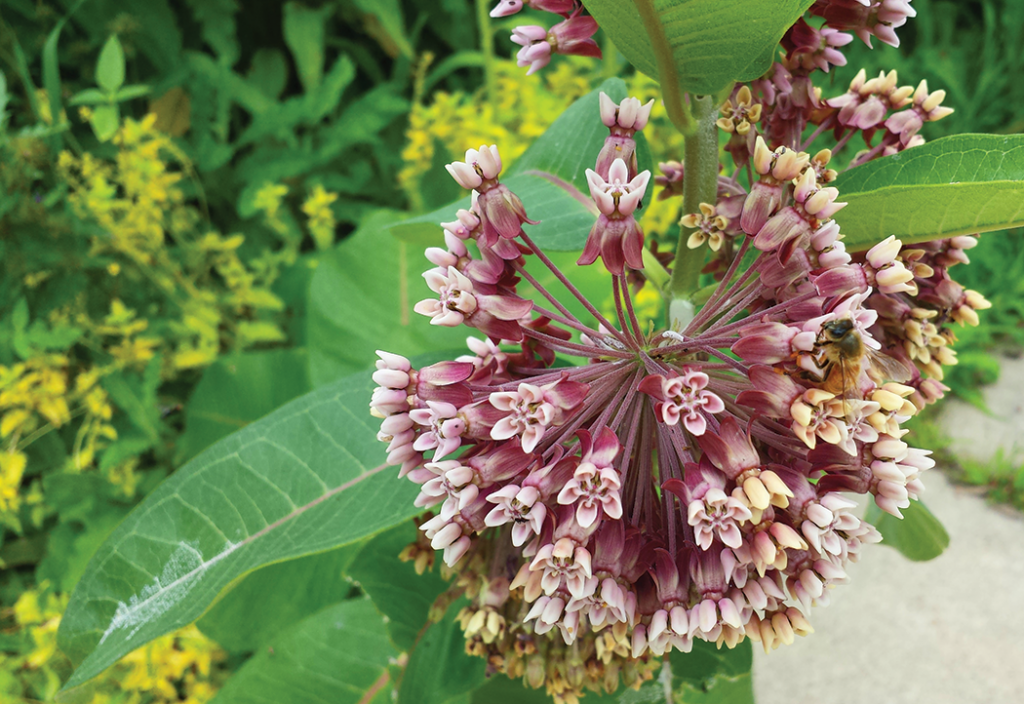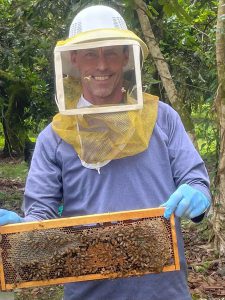Shawna Coronado
As an organic gardener, I often explore the idea of planting flowering plants in my garden – both native plants and more traditional perennials. My personal goal is to attract as many pollinators as possible, especially bees, so that we might preserve and encourage pollinators.
Bee Crisis
Pollinators exist as a part of a very complex ecosystem. While there is lots of arguing about the influences on the decrease in pollinator populations, it’s most likely a dozen differing traumas that come together to cause the devastating problem. One large concern is that the human population is growing. This means that more natural land space is consumed by the ever encroaching cement jungle. Add extreme weather changes, deforestation throughout the world, and urban pollution to the fray and you have a mix that causes a declining number of pollinating birds and insects. Without regular intervals of plants that enable pollinating creatures to sup, the butterflies, bees, and birds must travel at increasing distances over hot urban regions which contain intensely dwindling food sources.
Bees, in particular, have been hit remarkably hard. After intensive study of the matter, it has been discovered that enormous quantities of both agricultural and home pesticides and fungicides cling to the bees and can be found in hives and nests, causing illness and death amongst the hives. Additionally, mites and disease are causing extensive death in the colonies. Changes which are happening to the pollinator’s ecosystem, both natural and human-caused, combine to attack the pollinators where they live destroying their feeding corridors and colonies.
Why should you be concerned? Because the devastating act of losing millions of bees and other pollinators could also be the downfall of many of Earth’s primary vegetative food sources.
Reversing the Heat Island Effect
When I dream of an answer to this crisis, I often imagine a world where we all come together to build more food sources for the bee population. Urban areas around the world contain no-fly zones for pollinators because they are “heat islands.” Cities and urban areas have a lower percentage of vegetation and trees with higher percentages of cement walls, buildings, and parking lots. This generates excessive heat. One of the things each of us can do is start an initiative within the cities to plant trees and grow pollinator gardens to help cool the environment. As shaded areas increase, they can cool an area by 20 to 45°F. This gives pollinators a resting spot to find food and water. Should we think to build these resting areas closely together, we can create a pollinator corridor through the urban area connecting and protecting the pollinator family by providing a safe haven fly zone.
One of my hopes is that in writing my recent book, Grow a Living Wall: Create Vertical Gardens with Purpose, I might educate and inspire communities to consider the act of planting pollinator corridors through urban areas vertically along walls, fences, gates, and balconies. Giving pollinators a corridor to travel through city and suburban areas will increase their likelihood of survival. Additionally, building living pollinator walls which function as a pollinator corridor through urban areas is a step towards decreasing the heat island effect. An important part of having a pollinator garden is making sure that it is organic. Pollinators need a chemical-free place to sup and rest. Communities can come together around the world in order to build and manage pollinator gardens.
Imagine a revolutionary planting technique that lets you plant more than 30 plants in a floor area that only spans approximately one square foot. The trick is simply to grow up, not out. Gardening with this technique is amazingly simple and easy to accomplish for anyone. Sited on fences, gates, walls, balconies, and even doors, living wall gardens save enormous amounts of space, while producing an abundance of flowers, perennials, herbs, and vegetables.
How to Build a Vertical Pollinator Garden
There are five steps to growing a living wall:
- Make or build a unit,
- Put soil and organic fertilizer in the growing area,
- Plant it up with seeds or plants,
- Make sure it gets proper sun,
- Water regularly.
That is it. No weeding, no complicated chemical applications, and no challenging physical feats. Making a living wall yourself is easy; use window boxes and hang them 12 inches apart one on top of the other on a wall or fence. There are many styles of living wall systems or container garden systems in the marketplace which might enable you to grow a fabulous pollinator garden for your bee friends as well.
Once you have a unit built or purchased, simply prepare a heavy soil mix of 1 part organic potting soil with worm castings, one part compost, and one part rotted manure. Add organic fertilizer to the mix, then put the soil and fertilizer in the living wall and plant up the living wall system with pollinator friendly plants. Plant succulents and cacti in a soil mix that is built for planting cactus. All other plants do better in a raised system with a heavier soil mix with a strong percentage of organic water-absorbing ingredients.
Ground Plantings
While planting in living walls and container gardens with pollinator plants is convenient for balconies and patios, it is also possible to ground plant in other urban zones such as right-of-way areas, in empty lots, and along busy streets. Have the soil tested first to make sure there is no toxicity issues with the soil. Ask permission of the city, neighbors, or owner of the property before planting. Amend the soil with appropriate organic materials once you better understand the soil situation from your test results.
When considering ground plantings for bees, the first choice should always be native plants to your region. However, there are many terrific annuals that support bees while also supporting butterflies and hummingbirds. At the top of the annual list are alyssum, basil, borage, cosmos, zinnia, flowering tobacco, lantana, French marigold, sweet peas, sunflowers, and verbena. Perennial plants that are particularly attractive to bee pollinators include bee balm, butterfly weed, catmint, coneflower, coreopsis, anise hyssop, blazing star, lavender, milkweed, oregano, pincushion flower, and salvia. Let a few of your container and in-ground plants bolt; herbs, vegetables, and foliage annuals such as coleus which are allowed to flower are also wonderful nectar sources for pollinators.
Consider adding plants to your patio, balcony, or garden to help create a pollinator corridor in your community. Healthy bees means a healthier food system for your local community. Meet with neighbors and active community members to come together for a concentrated effort to make a difference for your bees and other pollinators.
Shawna Coronado is author of Grow a Living Wall: Create Vertical Gardens with Purpose. She is a columnist, blogger, photographer, and media host with green lifestyle living, organic gardening, and low-cost culinary who campaigns for social good. You can learn more about her at www.shawnacoronado.com.













